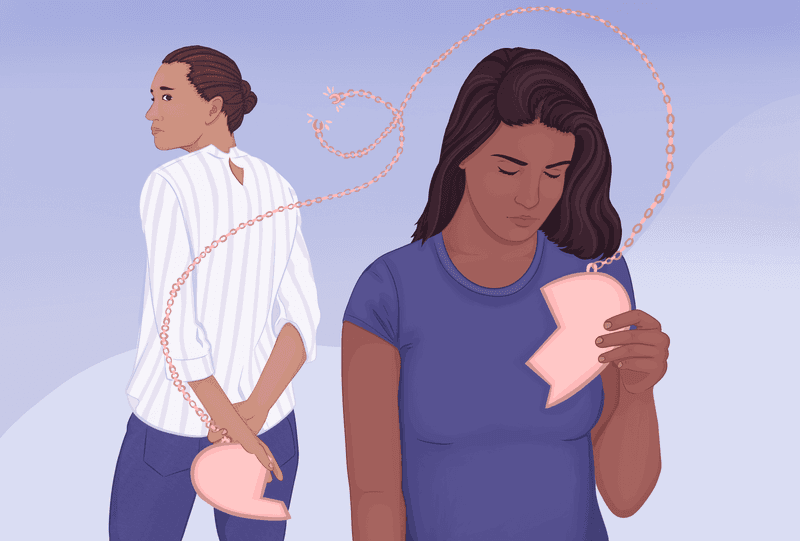15 Toughest Stages of a Relationship That Test True Love
Every love story has its chapters — the easy ones full of butterflies and bliss, and the harder ones filled with doubts, distance, and decisions.
But the truth is: the strongest relationships aren’t built in the honeymoon phase. They’re forged in the fire of the tough seasons — the parts no one posts about. These challenging moments aren’t just obstacles; they’re opportunities to grow deeper roots together.
When the filters come off and real life barges in, that’s when you discover if what you have is a passing feeling or the real deal. Ready for some real talk about the rocky patches? Here are 15 relationship stages that separate the fairytales from the love stories built to last.
1. The ‘Real You’ Reveal Stage

Remember that perfect person you fell for? They’re about to vanish. Three months in, the carefully curated version of yourselves starts cracking. Morning breath happens. Emotional baggage gets unpacked. That cute quirk becomes an irritating habit.
You’ll discover they’re terrible with money or that they call their mom three times daily. They’ll learn you’re not actually “chill” about everything. The masks slip, and suddenly you’re both standing there, gloriously imperfect. This stage feels like a bait-and-switch, but it’s actually the beginning of something authentic.
Many couples panic here, wondering if they made a mistake. But the relationships that survive don’t just tolerate the real person – they fall in love with them all over again, flaws and all. This isn’t about lowering standards; it’s about seeing someone completely and choosing them anyway.
2. The First Big Fight

There’s a powerful shift that happens when you realize love isn’t about avoiding conflict—it’s about learning how to move through it together. That moment of clarity can be surprising, even uncomfortable, but it’s also deeply liberating.
Love doesn’t shield you from hard conversations, misunderstandings, or emotional discomfort. Instead, it gives you the courage to face those moments with honesty, empathy, and care. It teaches you that real connection isn’t about perfection or constant peace, but about choosing each other even when things get messy.
Navigating conflict with love means listening more, judging less, and holding space for growth. It’s about finding strength in vulnerability and trust in the midst of uncertainty. That’s when love deepens—when it becomes not just a feeling, but a practice you return to, even when it’s hard.
3. The Intimacy Dry Spell

Remember when you couldn’t keep your hands off each other? When physical intimacy was spontaneous, frequent, and you both felt desired? Then life happened—work stress, body changes, kids, or just plain familiarity. Suddenly, intimacy becomes scheduled, predictable, or worse—nonexistent.
One partner usually wants more physical connection than the other. This imbalance creates a painful cycle: rejection makes the higher-desire partner feel unwanted, while the lower-desire partner feels pressured. Intimacy becomes a barometer for relationship health rather than just one aspect of your connection.
The strongest relationships recognize that desire naturally ebbs and flows, and sometimes passion needs intentional rekindling. A little effort goes a long way—whether that’s a hotel room staycation, a new shared experience, or simply putting phones away to focus completely on each other.
4. The Midlife Identity Crisis Curveball

One morning your partner wakes up and suddenly wants to quit their stable job to open a food truck. Or they’re researching motorcycle licenses. Or they’ve developed an intense interest in extreme fitness, spirituality, or going back to school. This isn’t just a new hobby—it’s existential panic in action.
Midlife identity shifts happen to most people, yet they blindside relationships. The changing partner feels trapped in their old life while their significant other feels abandoned or confused by these new priorities. What’s really happening? Someone’s confronting their mortality, questioning their life choices, and scrambling to find fulfillment before time runs out.
The couples who survive don’t mock these impulses or treat them as threats. Instead, they get curious about the legitimate needs beneath the surface. Sometimes compromises emerge—the food truck becomes a weekend pop-up, not a career change. Other times, both partners need to reimagine their future together, making space for evolving identities while keeping their core connection intact.
5. The Parallel Lives Phenomenon

You sleep in the same bed but live in different worlds. Between demanding careers, kids’ activities, and separate friend groups, you’ve become excellent roommates who sometimes reconnect physically. Your conversations revolve around logistics: Who’s taking the dog to the vet? Did you pay the electric bill?
This drift happens so gradually you barely notice until one day you look at your partner and wonder what they’re thinking about—and realize you haven’t wondered that in months. You’re both physically present but emotionally elsewhere. Your lives run alongside each other without meaningful intersection.
Couples who reconnect refuse to accept emotional distance as inevitable. They create non-negotiable rituals of connection: device-free dinners, morning coffee dates before the chaos begins, or weekend adventures that break routine.
6. The Pull of Outside Attraction

It starts innocently—a new coworker who really “gets” you, a gym buddy who makes you feel alive, or an old flame who slides into your DMs. Suddenly you’re thinking about this person constantly. You’re not cheating physically, but emotionally? That’s debatable.
Outside attractions test even rock-solid relationships. The new person represents escape from relationship problems, offering validation without the baggage of history. They’re all excitement and no responsibility. Meanwhile, your actual partner handles your moods, bills, and bathroom habits.
Successfully navigating this stage requires brutal self-honesty. The attraction itself isn’t the problem—it’s what you do with it. Healthy couples recognize these feelings as warning lights on the relationship dashboard. They use the wake-up call to address what’s missing at home: attention, appreciation, adventure.
7. The “We Communicate So Differently” Stage

Remember conversations that lasted until sunrise? Now you can barely discuss dinner plans without misunderstanding each other. One of you needs to process feelings out loud while the other retreats to think. One assumes the worst; the other avoids conflict entirely.
This communication breakdown feels like speaking different languages without a translator. You say something simple that triggers a massive fight, leaving both of you wondering how things escalated so quickly. The resulting silence creates more distance, making the next conversation even harder.
Couples who thaw this freeze learn to recognize their patterns. Maybe one partner needs to say “I need processing time” instead of stonewalling. Maybe the other needs to start difficult conversations with appreciation before diving into problems.
8. The Parenting Pressure Cooker

Life hits hard—maybe it’s a newborn who hasn’t slept more than two hours straight in months. Perhaps it’s caring for aging parents while working full-time. Or a health crisis that drains every ounce of energy. Whatever the cause, you’re both running on fumes, with nothing left to give each other.
During these survival-mode seasons, your relationship becomes functional rather than fulfilling. Date nights? Laughable luxury. Deep conversations? Too exhausting. Intimacy? You’d rather sleep. The danger isn’t the temporary sacrifice but normalizing it until emotional connection becomes permanently optional.
Couples who survive extreme exhaustion lower expectations without abandoning them completely. They find micro-moments of connection: holding hands while watching TV, texting appreciation throughout the day, or five-minute check-ins before sleep.
9. The Betrayal Phase

Everyone has secrets. Some are harmless, like pretending to love your partner’s signature dish. Others are relationship nuclear waste: hidden debt, addiction struggles, or emotional affairs. The longer they stay buried, the more toxic they become.
When secrets finally surface—and they almost always do—the betrayal isn’t just about the content. It’s about the sustained deception. The foundation of trust cracks. The revelation forces a question: If they hid this, what else don’t I know?
Surprisingly, some relationships emerge stronger after secrets explode—the forced honesty creates unprecedented intimacy. But this only happens when both partners commit to the painful, extended cleanup process rather than sweeping radioactive material under the relationship rug.
10. The First Major Life Setback

Major loss changes people—whether it’s a miscarriage, a parent’s death, career failure, or dreams that won’t materialize. Grief creates a personal black hole that can pull partners apart when they need each other most. One might process emotions openly while the other shuts down completely.
This mismatch in grieving styles creates profound loneliness. The expressive partner feels abandoned; the internal processor feels pressured. Anger gets misdirected at the closest target—each other. The relationship becomes collateral damage to pain neither person caused.
Couples who survive loss recognize grief as an individual journey that requires joint navigation. They give each other permission to mourn differently without taking it personally. Most importantly, they acknowledge that grief permanently changes both people, requiring them to get acquainted with these new versions of themselves and each other.
11. The Power Dynamic Earthquake

Your relationship had equilibrium—then everything shifted. Maybe one partner’s career skyrocketed while the other’s stalled. Perhaps someone became the primary caregiver, creating financial dependence. Or health problems made one person rely heavily on the other for basic needs.
These power imbalances shake relationship foundations. The higher-power partner may feel burdened by responsibility or secretly enjoy their increased control. The lower-power partner might resent their dependence or weaponize guilt. Both feel misunderstood in their new roles.
The strongest couples recognize that power constantly fluctuates throughout a lifetime together. Today’s provider might be tomorrow’s patient. What matters isn’t perfect equality at every moment but a commitment to mutual respect regardless of who temporarily holds more cards.
12. The Vulnerability Freeze

Your partner says something innocent that catapults you back to your worst childhood memory. Or their tone reminds you of an abusive ex. Suddenly you’re not fighting about loading the dishwasher—you’re fighting ghosts from another time, and your partner has no idea why.
Unhealed trauma creates relationship minefields. You both walk around triggering each other’s deepest wounds without realizing it. Small disagreements escalate instantly because they’re layered with past pain. Defense mechanisms developed long before you met each other create barriers to genuine connection.
Couples who break these cycles recognize when they’re responding to the past rather than the present moment. They develop pause buttons—”I need five minutes to check if this reaction fits what’s actually happening.”
13. The “Different Futures” Conversation

You built a life together around shared goals—then someone’s purpose completely changed. Maybe you agreed on being child-free, but your partner suddenly yearns for parenthood. Perhaps your religious beliefs diverged dramatically. Or one of you needs to relocate for meaningful work while the other needs community stability.
These fundamental shifts feel like bait-and-switch betrayals. The changing partner feels stifled by old agreements; the consistent one feels abandoned. Unlike smaller compromises, core purpose conflicts create painful questions: Is it selfish to pursue my calling at my partner’s expense? Is it controlling to expect them to honor our original plan?
The healthiest resolutions come when both partners genuinely try to understand the deeper needs behind the specific desire, searching for solutions that honor both people’s essential requirements for a meaningful life.
14. The Commitment Fatigue Stage

You’re finally alone together after a hectic week. Perfect opportunity to reconnect, right? Except one of you is scrolling Instagram while the other watches TikTok. Physical presence, emotional absence.
Our devices create unprecedented competition for attention in relationships. That dopamine hit from notifications feels more immediately rewarding than the slow burn of intimate conversation. Screens become both escape hatches from discomfort and walls against genuine connection.
Couples surviving the digital age create technology boundaries that prioritize their relationship. Maybe phones stay in another room during dinner, or they establish screen-free Sundays. Perhaps they replace mindless scrolling with shared online activities—taking a virtual cooking class together instead of consuming content separately while sitting side by side.
15. The “Have We Changed Too Much?” Phase

One day you wake up beside someone who looks like your partner but seems like a complete stranger. Their political views have radicalized in the opposite direction. Their personality has morphed dramatically. Their values have fundamentally shifted. Who is this person, and what happened to the one you fell in love with?
People change—sometimes gradually, sometimes suddenly after trauma or life-altering experiences. These transformations create existential questions: Do I still know this person? Do we still want the same things? Is this change temporary or permanent?
The healthiest outcomes happen when both partners recognize that no one stays exactly the same throughout life. True love isn’t about preserving someone in amber—it’s about choosing them repeatedly as both of you continuously become different versions of yourselves.







